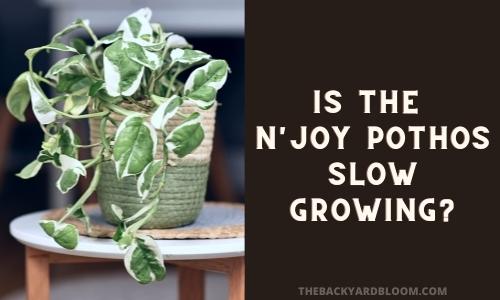If you are a pothos collector, you have probably heard of the N’Joy Pothos or perhaps you already own one. Many who pick up their first N’Joy Pothos plant notice there are some differences in caring for this variety and one of those differences is the growth rate. Often the most common question asked is if The N’Joy Pothos is a slow-growing plant from new owners.
See our Care Guide for N’Joy Pothos for more information on how to take care of your N’Joy Pothos.

The N’Joy Pothos has some differences that set it apart from the more frequently seen Pothos varieties such as the Golden Pothos or Marble Queen Pothos. The N’Joy Pothos has smaller leaves and unique variegation of green and cream colors that are very segmented, and they do not have specs of green in the white part of the leaf.
Is The N’Joy Pothos Slow Growing?
When compared to other more common types of Pothos plants, yes N’Joy Pothos is a slow-growing plant. There is no direct given rate at which a N’Joy Pothos plant grows. But many owners of this plant notice that they grow at a considerably slower rate than their other pothos plants. Some owners have said that their N’Joy Pothos is growing about a third of the rate as their other Pothos.
The other type of Pothos plant that shares about the same growth rate with a N’Joy is the similar slow-growing Pearls and Jade Pothos. This makes these two Pothos ideal for those with smaller spaces since you don’t have to worry about vining houseplants growing fast and all over things.
Related Reading:
- Why Is My Marble Queen Pothos Losing Variegation?
- How to Propagate Pothos Plants in Water from Cuttings (With Pictures)
- Why Is My Pothos Dripping Water?
- Can a Pothos Get Sunburn?
Why Do N’Joy Pothos Have A Slow Growth Rate?
N’Joy Pothos leaves have more white/cream variegation than some of the faster-growing pothos varieties like Golden Pothos.
The green section of the leaf is where there are chloroplasts. Chloroplasts, when they are normal, convert light energy into chemical energy for the plant to use by the process of photosynthesis. The less green color on the leaves means fewer normal-appearing chloroplasts in the plant. Normal chloroplasts exist in the green portion of the plant leaves. The white portions of the leaves have what appear to be blocked stages of chloroplast biogenesis.
Since chloroplasts are needed and fully functioning for the plant to make energy and there aren’t as many on N’Joy Pothos, there is less energy for the plant to use to grow. This is why the other types of Pothos that have more green on the leaves will grow faster.
Other Reasons N’Joy Pothos Might Be Growing Slow
Pothos plants, like most plants, have a growing cycle. In the fall and winter, the plant will not grow as much. So if you are in the middle of winter and are wondering why your N’Joy is growing slowly, it could just be because it is in its dormant phase.
During the spring and summer, the plant will be in its growing stage. If you are still not seeing any growth it could be because you should fertilize your Pothos twice during the growing period. Use a liquid fertilizer at about half dose, once at the start of spring and again in the summer.
Another reason that a N’Joy Pothos could be growing slow is due to damaged roots. Pothos plants are susceptible to root rot. Damage caused by root rot can make it so the plant cannot take up water or nutrients.
Is There a Way to Make a N’Joy Pothos Grow Faster?
There are things you can do to help give the plant what it needs to grow at the fastest rate it can.
Light is the number one factor when it comes to growth rate and a N’Joy pothos. Since the variegation on the leaves is what causes the plant to have a lower ability to do photosynthesis, providing it with more light will allow the green parts of the leaves to work as hard as they can to create the energy the plant needs to grow. Just make sure that you don’t place your N’Joy in direct sunlight. They need bright indirect light.
Providing your N’Joy with fertilizer in its growing season can also help with the growth rate. Use a liquid fertilizer at half the recommended dose twice during the growing seasons of spring and summer. Pothos plants are not heavy feeders so they don’t need a heavy fertilizing schedule.
References:
- Structure and Function of Chloroplasts, https://www.frontiersin.org/research-topics/5623/structure-and-function-of-chloroplasts
- Variegation mutants and mechanisms of chloroplast biogenesis, 2007, PubMed.gov, https://pubmed.ncbi.nlm.nih.gov/17263779/